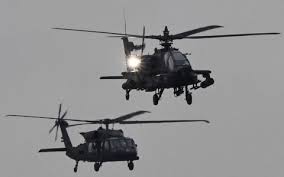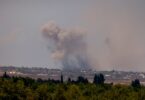David Axe
For wartime missions, the helicopter is dead. Well, mostly. The US Army – the world’s biggest helicopter force – dramatically took a budgetary axe to its multi-billion-dollar portfolio of rotorcraft programs last week, canceling a next-generation scout helicopter as well as an effort to upgrade hundreds of decades-old transport helicopters.
It’s no secret what motivated the Army leadership to take such drastic measures. “We are learning from the battlefield – especially in Ukraine – that aerial reconnaissance has fundamentally changed,” said General Randy George, the Army’s top officer. An absolute bloodbath among helicopter pilots on both sides of Russia’s two-year wider war on Ukraine explains the US Army’s sense of urgency. Inasmuch as the helicopter is dying, the Ukraine war is killing it. Most likely, rotorcraft will endure into their second century: but in very different roles.
In the months leading up to Russia’s further invasion of Ukraine in February 2022, it was mostly business as usual in Russian and Ukrainian helicopter regiments. They scouted ahead of the front lines, prepared for close-air-support missions directly attacking enemy forces and also transported troops along the front. But after the Russians attacked, a whole lot of old ways proved virtually suicidal. Ground-based air-defenses – guns and missiles – were always a serious threat to slow-flying rotorcraft. As it turns out, they’re a much bigger threat than almost anyone realized. Helicopters have dropped like flies on both sides. According to a running tally by the analysts at the intelligence collective Oryx, the Russians have lost around a hundred of their pre-war force of 800 or so attack and transport helicopters. The Ukrainians have, for their part, lost half of their 60 or so helicopters – although they’ve gotten, from their allies, more than 80 helicopters as replacements.
The devastating loss of helicopters and, more importantly, their crews compelled the Russian and Ukrainian air forces to radically change what they use their helicopters for. Put simply, helicopters no longer fly anywhere near the front line unless the circumstances are truly extraordinary. One extraordinary circumstance was the Russian army’s encirclement of the port of Mariupol in southern Ukraine in the spring of 2022. In a desperate bid to resupply the city’s besieged garrison and retrieve the wounded, Ukrainian transport helicopters flew scores of miles mere feet off the ground in order to reach Mariupol without tipping off Russian air-defenders.
At least three of the helicopters didn’t make it in, or back. Mariupol was the exception. By mid-2022, the closest a helicopter got to the front line under normal circumstances was a few miles. Russian and Ukrainian rotorcraft continued to haul troops and supplies – but not too close to the fighting. They also continued to launch attacks on enemy troops – but usually from miles away, using unguided rockets they lobbed at high angles like artillery. And yet rotorcraft still fell from the sky in startling numbers. Russian attack helicopters were especially vulnerable as they hovered for 30 seconds or longer while their crew tried to steer command-guided anti-tank missiles. The Russians have lost perhaps a third of their best Ka-52 attack ‘copters. The US Army isn’t willing to risk its own helicopters over the front line of some future war. So it simply canceled the helicopter whose mission would have required it to fly close to enemy forces: the futuristic Future Attack Reconnaissance Aircraft scout helicopter. The American ground-combat branch also axed an effort to upgrade 700 or more older Blackhawk transport helicopters. US Army leaders soothed their aviators – and the United States’ sprawling rotorcraft industrial base – by promising to reinvest billions of dollars in savings in other helicopter programs, including expanded production of a new Blackhawk model as well as the latest version of the twin-rotor Chinook heavy-lift helicopter. Notably, neither of these types would have to fly very close to the front line in order to remain relevant. If there’s a big open question, it’s what America plans to do with its hundreds of Apache attack helicopters, which do have to fly close to the front line.
The likely answer has been apparent for a while now. The US Army is upgrading its Apaches to the new “Block E” version, which includes controls and radio links in the cockpit that allow the crew to control drones that operate 30 miles or more ahead of the helicopter. “This combination results in increased survivability of Apache aircrews,” Army colonel Steven Van Riper explained. Unshockingly, drones are the solution to a lot of the US Army’s rotorcraft problems. As it grounds more and more helicopters, the Army is launching more and more drones. One of the things the service said it would do with its rotorcraft savings is “increase investments in research and development to expand and accelerate the Army’s unmanned aerial reconnaissance capability.”
Again, the Ukraine war is showing how it’s done. Today the air over the 600-mile front line in Ukraine might be mostly devoid of manned helicopters. But it’s practically teeming with drone helicopters, especially small reusable quadcopters, hexacopters and octocopters as well as single-used quadcopters packed with around a pound of explosives.
The Ukrainians, who retain a robotics advantage over the Russians, are building and launching as many as 50,000 small drones a month. Who needs to risk a $25-million helicopter and its crew when you can fill the air with thousands of drones, none costing more than a few thousand dollars?
The Telegraph







